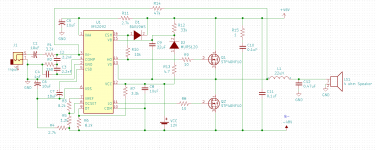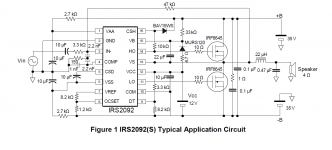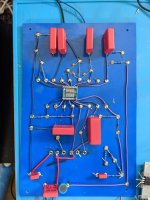Hey, I have tried to build a Class D power amp from the reference design in the IRS2092 datasheets and other reference notes. I am attaching the schematic as I've built it. (the reference used different mosfets and B+/B- of 35vdc but I found a few 48VDC so I changed to some 100VDC 50A mosfets (listed in the schematic). I used my desktop power supply for the 12V VCC.
I powered it on and it gave me some periodic pop noise but nothing else. I then realized I'd not connected the input sides GND to the output side so I jumpered them together. there was a pop and the magic smoke came out of the IRS2092. I'm unsure of why this happened, and was hoping maybe some of the class d guru's here might have suggestions?
I'm attaching the schematic with the values I used.
Thanks!
I powered it on and it gave me some periodic pop noise but nothing else. I then realized I'd not connected the input sides GND to the output side so I jumpered them together. there was a pop and the magic smoke came out of the IRS2092. I'm unsure of why this happened, and was hoping maybe some of the class d guru's here might have suggestions?
I'm attaching the schematic with the values I used.
Thanks!
Attachments
I guess I realize I didn't actually ask a question....
Does anyone see anything wrong with the schematic as noted? Again this came directly from the reference design from infineon, seems pretty straightforward to me, but I come from the tube amp side of things and solid state stuff is still new-ish to me. I understand how mosfets/fets/transistors work, op amps work etc, but just haven't done any deeper digging into a circuit like this to understand why the IC died...
Thanks!
~Phil
Does anyone see anything wrong with the schematic as noted? Again this came directly from the reference design from infineon, seems pretty straightforward to me, but I come from the tube amp side of things and solid state stuff is still new-ish to me. I understand how mosfets/fets/transistors work, op amps work etc, but just haven't done any deeper digging into a circuit like this to understand why the IC died...
Thanks!
~Phil
How did you connect 12v supply for vcc. Please note it is negative reference. You might have supplied 12v ground referred. Please check it.
I connected the 12VDC negative to the B- rail as shown in the schematic.
I did get an update at eevblog that made me note that one version of the reference document doesn't have a 150pF cap to ground on the NFB line, but it does on another, and that may be part of the problem, I'm attaching the two versions I now know of, the one w/o the cap to ground on NFB was the one I used, but I just found this other one that has one. Maybe they found an error in their reference design and added that cap to fix it? Does that seem like a logical problem that could cook the IC? If it started oscillation of some kind?
~Phil
I did get an update at eevblog that made me note that one version of the reference document doesn't have a 150pF cap to ground on the NFB line, but it does on another, and that may be part of the problem, I'm attaching the two versions I now know of, the one w/o the cap to ground on NFB was the one I used, but I just found this other one that has one. Maybe they found an error in their reference design and added that cap to fix it? Does that seem like a logical problem that could cook the IC? If it started oscillation of some kind?
~Phil
Attachments
Here's the board, no PCB, just FR4 with eyelets, I usually do Tube amps so this is what I had at hand to easily prototype it.
Not sure how it will be oriented, but the mosfets burned when i did some testing post smoke out. The mosfets empty holes are on the output side, the input is the opposite, I used a pcb to through hole mini board so I could mount the IRS2092 easily in this format.
Not sure how it will be oriented, but the mosfets burned when i did some testing post smoke out. The mosfets empty holes are on the output side, the input is the opposite, I used a pcb to through hole mini board so I could mount the IRS2092 easily in this format.
Attachments
Irs2092 is very sketchy about pcb layout. Even it won't work properly on breadboard. No wonders yours failed.
I'm not sure I understand what that means. Could you elaborate on what specific layout problems that need overcoming?
~Phil
~Phil
Here's the board, no PCB, just FR4 with eyelets, I usually do Tube amps so this is what I had at hand to easily prototype it.
Not sure how it will be oriented, but the mosfets burned when i did some testing post smoke out. The mosfets empty holes are on the output side, the input is the opposite, I used a pcb to through hole mini board so I could mount the IRS2092 easily in this format.
wait are you serious ? you cannot expect this to work right? you just used a tube layout on a class-d amplifier.
I am serious. I have no context telling me why it wouldn't work. Yes I'm sure I'm the noobest moron that's ever tried something. I do think, though, that probably telling me why it won't work is better than showing incredulity at my imbecilic attempts to learn.
Sincerest thanks!
Sincerest thanks!
So again based on my very limited experience with solid state amplifiers, slew rate seems to be related to how distorted the output would be compared to the input. but at this time I had no input, I just powered it on to try to and see if it even worked... The input jack was not sending anything 'in'.
I might be talking about the completely wrong concept because simply throwing out slew rates for something I've never done or needed to understand is like throwing out gravitational constants to bees.
If I could get a basic understanding to a pretty much layman (I have built, repaired and played with many circuits, but my audio experience was in the past limited to tube amps) that would be greatly appreciated.
If this forum is not the right place to learn, I'll simply not waste your time anymore. I can delete all the content of the thread and go elsewhere.
My best explanation of what I expected was more than 1 sentence extremely technical jargon with no context, but again, maybe I'm just to stupid to understand these concepts and I should go build kites.
I might be talking about the completely wrong concept because simply throwing out slew rates for something I've never done or needed to understand is like throwing out gravitational constants to bees.
If I could get a basic understanding to a pretty much layman (I have built, repaired and played with many circuits, but my audio experience was in the past limited to tube amps) that would be greatly appreciated.
If this forum is not the right place to learn, I'll simply not waste your time anymore. I can delete all the content of the thread and go elsewhere.
My best explanation of what I expected was more than 1 sentence extremely technical jargon with no context, but again, maybe I'm just to stupid to understand these concepts and I should go build kites.
Mods, can you please delete this thread and delete my attachments. It's obvious I don't deserve to be on this thread, and I don't want to waste anyone else's time reading my stupidity.
I can't remove, edit or delete my own posts. I would really like if you deleted my account and all my content here, thanks.
I can't remove, edit or delete my own posts. I would really like if you deleted my account and all my content here, thanks.
Mods, can you please delete this thread and delete my attachments. It's obvious I don't deserve to be on this thread, and I don't want to waste anyone else's time reading my stupidity.
I can't remove, edit or delete my own posts. I would really like if you deleted my account and all my content here, thanks.

We wouldn't normally delete your thread, that is unfair on those who took the time to reply...
We have all had to learn starting from zero and that is often hard won knowledge. I would suggest you stick around and keep asking questions 🙂 or at the very least keep browsing the threads.
And remember, you are not under any obligation to keep posting, you can always withdraw gracefully from any discussion by just not posting.
If you really really want your account 'disabling' (which is what we do) then report this post of mine and it will be done.
pompeiisneaks
Need started from Zero. Otherwise it will be hard to understand.
Sorry, my English is bad))))
Need started from Zero. Otherwise it will be hard to understand.
Sorry, my English is bad))))
I don't really want historic record of this level of 'help'. They took the time to tell me how stupid I am, and not actually answer any of my questions.
answers like
"Bro, Slew rate on tube - 20v max
in class D 3000-6000v"
to my experience isn't helpful, because it doesn't relate to 'how the ic burned up' it just throws a fact out that in my limited experience answers nothing, at least it had information in it, but at least I can read up on what the hell slew rate is and how it relates. (I did and I can't see how it relates such an idiot)
The other 'super helpful' answers like
"Irs2092 is very sketchy about pcb layout. Even it won't work properly on breadboard. No wonders yours failed."
and
"wait are you serious ? you cannot expect this to work right? you just used a tube layout on a class-d amplifier."
are proof these people are so much smarter and better than I am, that they can't even take an extra 10 seconds to actually answer the question, they just take time to show how dumb I am, and how little time I deserve. I don't want to be a part of that kind of 'community'
answers like
"Bro, Slew rate on tube - 20v max
in class D 3000-6000v"
to my experience isn't helpful, because it doesn't relate to 'how the ic burned up' it just throws a fact out that in my limited experience answers nothing, at least it had information in it, but at least I can read up on what the hell slew rate is and how it relates. (I did and I can't see how it relates such an idiot)
The other 'super helpful' answers like
"Irs2092 is very sketchy about pcb layout. Even it won't work properly on breadboard. No wonders yours failed."
and
"wait are you serious ? you cannot expect this to work right? you just used a tube layout on a class-d amplifier."
are proof these people are so much smarter and better than I am, that they can't even take an extra 10 seconds to actually answer the question, they just take time to show how dumb I am, and how little time I deserve. I don't want to be a part of that kind of 'community'
pompeiisneaks
Need started from Zero. Otherwise it will be hard to understand.
Sorry, my English is bad))))
🙂 it just meant that we all started from not knowing anything. We all had to learn the very basics first and then build on that knowledge.
being a noob is a good thing, but the response to a noob trying to learn is what makes them become either a learner, and eventually maybe a good or even great person in an area, and someone that just goes and looks for other information or other things to do.
If you're a noob, spend tons of time reading, learning and try and fail, and ask someone for help and they treat you like garbage, you often become the latter. I think I will as well.
All I've learned from this thread is that 'I can only use pcb' and 'slew rates' not why or how. or what I did wrong other than 'got the pcb and slew rate wrong' ? I guess? I'm farther than where I started. I again, would appreciate if the thread were deleted. Unless you hope it can be a cautionary tale to scare away other neophytes hoping to learn.
~Phil
If you're a noob, spend tons of time reading, learning and try and fail, and ask someone for help and they treat you like garbage, you often become the latter. I think I will as well.
All I've learned from this thread is that 'I can only use pcb' and 'slew rates' not why or how. or what I did wrong other than 'got the pcb and slew rate wrong' ? I guess? I'm farther than where I started. I again, would appreciate if the thread were deleted. Unless you hope it can be a cautionary tale to scare away other neophytes hoping to learn.
~Phil
- Home
- Amplifiers
- Class D
- IRS2092 Class D build. BURNED :D



